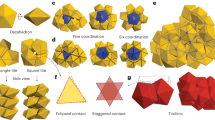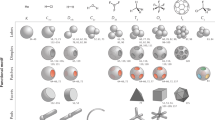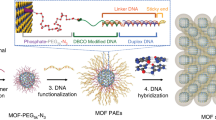Abstract
Colloidal crystal engineering of complex, low-symmetry architectures is challenging when isotropic building blocks are assembled. Here we describe an approach to generating such structures based upon programmable atom equivalents (nanoparticles functionalized with many DNA strands) and mobile electron equivalents (small particles functionalized with a low number of DNA strands complementary to the programmable atom equivalents). Under appropriate conditions, the spatial distribution of the electron equivalents breaks the symmetry of isotropic programmable atom equivalents, akin to the anisotropic distribution of valence electrons or coordination sites around a metal atom, leading to a set of well-defined coordination geometries and access to three new low-symmetry crystalline phases. All three phases represent the first examples of colloidal crystals, with two of them having elemental analogues (body-centred tetragonal and high-pressure gallium), while the third (triple double-gyroid structure) has no known natural equivalent. This approach enables the creation of complex, low-symmetry colloidal crystals that might find use in various technologies.
This is a preview of subscription content, access via your institution
Access options
Access Nature and 54 other Nature Portfolio journals
Get Nature+, our best-value online-access subscription
$29.99 / 30 days
cancel any time
Subscribe to this journal
Receive 12 print issues and online access
$259.00 per year
only $21.58 per issue
Buy this article
- Purchase on Springer Link
- Instant access to full article PDF
Prices may be subject to local taxes which are calculated during checkout






Similar content being viewed by others
Data availability
All other data generated or analysed during this study are included in the Supplementary Information. Further data are available from the corresponding authors upon request. Source data are provided with this paper
Code availability
The source code for HOOMD-blue is available at https://github.com/glotzerlab/hoomd-blue. The source code for the SAXS simulation is available at https://sites.google.com/site/byeongdu/software. The lattice segmentation and analysis codes for the electron microscopy images are available at https://github.com/JingshanDu/ImageLatticeAnalysis.
References
Lewis, G. N. The atom and the molecule. J. Am. Chem. Soc. 38, 762–785 (1916).
Pauling, L. The Nature of the Chemical Bond, and the Structure of Molecules and Crystals: An Introduction to Modern Structural Chemistry 2nd edn (Cornell Univ. Press, 1940).
Kalsin, A. M. et al. Electrostatic self-assembly of binary nanoparticle crystals with a diamond-like lattice. Science 312, 420–424 (2006).
Shevchenko, E. V., Talapin, D. V., Kotov, N. A., O’Brien, S. & Murray, C. B. Structural diversity in binary nanoparticle superlattices. Nature 439, 55–59 (2006).
Boles, M. A., Engel, M. & Talapin, D. V. Self-assembly of colloidal nanocrystals: from intricate structures to functional materials. Chem. Rev. 116, 11220–11289 (2016).
Glotzer, S. C. & Solomon, M. J. Anisotropy of building blocks and their assembly into complex structures. Nat. Mater. 6, 557–562 (2007).
Damasceno, P. F., Engel, M. & Glotzer, S. C. Predictive self-assembly of polyhedra into complex structures. Science 337, 453–457 (2012).
Wang, Y. F. et al. Colloids with valence and specific directional bonding. Nature 491, 51–55 (2012).
Huang, M. J. et al. Selective assemblies of giant tetrahedra via precisely controlled positional interactions. Science 348, 424–428 (2015).
Liu, W. Y. et al. Diamond family of nanoparticle superlattices. Science 351, 582–586 (2016).
Lin, H. X. et al. Clathrate colloidal crystals. Science 355, 931–935 (2017).
Yi, C. et al. Self-limiting directional nanoparticle bonding governed by reaction stoichiometry. Science 369, 1369–1374 (2020).
He, M. X. et al. Colloidal diamond. Nature 585, 524–529 (2020).
Mirkin, C. A., Letsinger, R. L., Mucic, R. C. & Storhoff, J. J. A DNA-based method for rationally assembling nanoparticles into macroscopic materials. Nature 382, 607–609 (1996).
Park, S. J., Lazarides, A. A., Storhoff, J. J., Pesce, L. & Mirkin, C. A. The structural characterization of oligonucleotide-modified gold nanoparticle networks formed by DNA hybridization. J. Phys. Chem. B 108, 12375–12380 (2004).
Park, S. Y. et al. DNA-programmable nanoparticle crystallization. Nature 451, 553–556 (2008).
Nykypanchuk, D., Maye, M. M., van der Lelie, D. & Gang, O. DNA-guided crystallization of colloidal nanoparticles. Nature 451, 549–552 (2008).
Jones, M. R., Seeman, N. C. & Mirkin, C. A. Programmable materials and the nature of the DNA bond. Science 347, 1260901 (2015).
Macfarlane, R. J. et al. Nanoparticle superlattice engineering with DNA. Science 334, 204–208 (2011).
Girard, M. et al. Particle analogs of electrons in colloidal crystals. Science 364, 1174–1178 (2019).
Wang, S. Z. et al. Colloidal crystal "Alloys". J. Am. Chem. Soc. 141, 20443–20450 (2019).
Auyeung, E. et al. DNA-mediated nanoparticle crystallization into Wulff polyhedra. Nature 505, 73–77 (2014).
Auyeung, E., Macfarlane, R. J., Choi, C. H. J., Cutler, J. I. & Mirkin, C. A. Transitioning DNA-engineered nanoparticle superlattices from solution to the solid state. Adv. Mater. 24, 5181–5186 (2012).
Laramy, C. R., O’Brien, M. N. & Mirkin, C. A. Crystal engineering with DNA. Nat. Rev. Mater. 4, 201–224 (2019).
Anderson, J. A., Glaser, J. & Glotzer, S. C. HOOMD-blue: a Python package for high-performance molecular dynamics and hard particle Monte Carlo simulations. Comput. Mater. Sci. 173, 109363 (2020).
Akcora, P. et al. Anisotropic self-assembly of spherical polymer-grafted nanoparticles. Nat. Mater. 8, 354–359 (2009).
Pólya, G., Mathematics and Plausible Reasoning (Oxford Univ. Press, 1954).
Iacovella, C. R., Keys, A. S., Horsch, M. A. & Glotzer, S. C. Icosahedral packing of polymer-tethered nanospheres and stabilization of the gyroid phase. Phys. Rev. E 75, 040801 (2007).
Hyde, S. T., O’Keeffe, M. & Proserpio, D. M. A short history of an elusive yet ubiquitous structure in chemistry, materials, and mathematics. Angew. Chem. Int. Ed. 47, 7996–8000 (2008).
Longley, W. & McIntosh, T. J. A bicontinuous tetrahedral structure in a liquid-crystalline lipid. Nature 303, 612–614 (1983).
Prasad, I., Jinnai, H., Ho, R. M., Thomas, E. L. & Grason, G. M. Anatomy of triply-periodic network assemblies: characterizing skeletal and inter-domain surface geometry of block copolymer gyroids. Soft Matter 14, 3612–3623 (2018).
Saba, M., Turner, M. D., Mecke, K., Gu, M. & Schröder-Turk, G. E. Group theory of circular-polarization effects in chiral photonic crystals with four-fold rotation axes applied to the eight-fold intergrowth of gyroid nets. Phys. Rev. B 88, 245116 (2013).
Saba, M. et al. Circular dichroism in biological photonic crystals and cubic chiral nets. Phys. Rev. Lett. 106, 103902 (2011).
Kirkensgaard, J. J., Evans, M. E., de Campo, L. & Hyde, S. T. Hierarchical self-assembly of a striped gyroid formed by threaded chiral mesoscale networks. Proc. Natl Acad. Sci. USA 111, 1271–1276 (2014).
Casey, M. et al. Driving diffusionless transformations in colloidal crystals using DNA handshaking. Nat. Commun. 3, 1209 (2012).
Zhang, Y. et al. Selective transformations between nanoparticle superlattices via the reprogramming of DNA-mediated interactions. Nat. Mater. 14, 840–847 (2015).
Mao, R., Pretti, E. & Mittal, J. Temperature-controlled reconfigurable nanoparticle binary superlattices. ACS Nano 15, 8466–8473 (2021).
Du, C. X., van Anders, G., Newman, R. S. & Glotzer, S. C. Shape-driven solid–solid transitions in colloids. Proc. Natl Acad. Sci. USA 114, E3892–E3899 (2017).
Sandoval, L., Urbassek, H. M. & Entel, P. The Bain versus Nishiyama–Wassermann path in the martensitic transformation of Fe. New J. Phys. 11, 103027 (2009).
Lee, S., Leighton, C. & Bates, F. S. Sphericity and symmetry breaking in the formation of Frank–Kasper phases from one component materials. Proc. Natl Acad. Sci. USA 111, 17723–17731 (2014).
Li, B., Zhou, D. & Han, Y. L. Assembly and phase transitions of colloidal crystals. Nat. Rev. Mater. 1, 15011 (2016).
Hanfland, M., Syassen, K., Christensen, N. E. & Novikov, D. L. New high-pressure phases of lithium. Nature 408, 174–178 (2000).
Hobbs, D., Hafner, J. & Spisak, D. Understanding the complex metallic element Mn. I. Crystalline and noncollinear magnetic structure of α-Mn. Phys. Rev. B 68, 014407 (2003).
McMahon, M. I. & Nelmes, R. J. High-pressure structures and phase transformations in elemental metals. Chem. Soc. Rev. 35, 943–963 (2006).
Seddon, J. M. Structure of the inverted hexagonal (HII) phase, and non-lamellar phase-transitions of lipids. Biochim Biophys. Acta 1031, 1–69 (1990).
Iacovella, C. R., Keys, A. S. & Glotzer, S. C. Self-assembly of soft-matter quasicrystals and their approximants. Proc. Natl Acad. Sci. USA 108, 20935–20940 (2011).
Sun, H. J., Zhang, S. D. & Percec, V. From structure to function via complex supramolecular dendrimer systems. Chem. Soc. Rev. 44, 3900–3923 (2015).
Lee, S., Bluemle, M. J. & Bates, F. S. Discovery of a Frank-Kasper σ phase in sphere-forming block copolymer melts. Science 330, 349–353 (2010).
Ziherl, P. & Kamien, R. D. Maximizing entropy by minimizing area: towards a new principle of self-organization. J. Phys. Chem. B 105, 10147–10158 (2001).
Li, T., Senesi, A. J. & Lee, B. Small angle X-ray scattering for nanoparticle research. Chem. Rev. 116, 11128–11180 (2016).
Park, J. et al. Direct observation of wet biological samples by graphene liquid cell transmission electron microscopy. Nano Lett. 15, 4737–4744 (2015).
Dabov, K., Foi, A., Katkovnik, V. & Egiazarian, K. Image denoising by sparse 3-D transform-domain collaborative filtering. IEEE Trans. Image Process. 16, 2080–2095 (2007).
Nguyen, T. D., Phillips, C. L., Anderson, J. A. & Glotzer, S. C. Rigid body constraints realized in massively-parallel molecular dynamics on graphics processing units. Comput. Phys. Commun. 182, 2307–2313 (2011).
Glaser, J., Zha, X., Anderson, J. A., Glotzer, S. C. & Travesset, A. Pressure in rigid body molecular dynamics. Comput. Mater. Sci. 173, 109430 (2020).
Towns, J. et al. XSEDE: accelerating scientific discovery. Comput. Sci. Eng. 16, 62–74 (2014).
Chandler, D., Weeks, J. D. & Andersen, H. C. Van der Waals picture of liquids, solids, and phase transformations. Science 220, 787–794 (1983).
Knorowski, C., Burleigh, S. & Travesset, A. Dynamics and statics of DNA-programmable nanoparticle self-assembly and crystallization. Phys. Rev. Lett. 106, 215511 (2011).
Angioletti-Uberti, S., Mognetti, M. B. & Frenkel, D. Theory and simulation of DNA-coated colloids: a guide for rational design. Phys. Chem. Chem. Phys. 18, 6373–6393 (2016).
Rogers, W. B. & Crocker, J. C. Direct measurements of DNA-mediated colloidal interactions and their quantitative modeling. Proc. Natl Acad. Sci. USA 108, 15687–15692 (2011).
Li, T. I. N. G., Sknepnek, R., Macfarlane, R. J., Mirkin, C. A. & de la Cruz, M. O. Modeling the crystallization of spherical nucleic acid nanoparticle conjugates with molecular dynamics simulations. Nano Lett. 12, 2509–2514 (2012).
Ramasubramani, V. et al. freud: a software suite for high throughput analysis of particle simulation data. Comput. Phys. Commun. 254, 107275 (2020).
Steinhardt, P. J., Nelson, D. R. & Ronchetti, M. Bond-orientational order in liquids and glasses. Phys. Rev. B 28, 784–805 (1983).
Acknowledgements
We thank E. W. Roth (Northwestern University (NU)) for ultramicrotomy, S. Weigand (NU) for SAXS assistance and A. Das (NU) for helpful discussions. This work was supported primarily by the Center for Bio-Inspired Energy Science, an Energy Frontier Research Center funded by the US Department of Energy, Office of Science, Basic Energy Sciences (award DE-SC0000989, for synthesis and molecular dynamics simulations, C.A.M. and S.C.G.) and also by the Air Force Office of Scientific Research (award FA9550-17-1-0348, for synthesis, spectroscopy and electron microscopy, C.A.M. and V.P.D.) and the Sherman Fairchild Foundation (for electron microscopy, C.A.M.). This work made use of the EPIC facility of Northwestern University’s NUANCE Center, which has received support from the SHyNE Resource (NSF ECCS-2025633), the IIN and Northwestern’s MRSEC programme (NSF DMR-1720139). This research also used the resources (Sector 5, the DuPont-Northwestern-Dow Collaborative Access Team ‘DND-CAT’, beamline 12-ID-B) of the Advanced Photon Source, which is a US Department of Energy Office of Science User Facility operated by Argonne National Laboratory (contract DE-AC02-06CH11357). Simulations were carried out using the resources at the Oak Ridge Leadership Computing Facility, which is a DOE Office of Science User Facility (supported under contract DE-AC05-00OR22725). Computational resources and services were also provided by Advanced Research Computing at the University of Michigan.
Author information
Authors and Affiliations
Contributions
C.A.M. and S.C.G. directed the research. S.W. performed the synthesis and X-ray scattering experiments. S.L. performed the MD simulations. J.S.D. and S.W. performed the electron microscopy studies. S.W. and B.L. performed the SAXS simulations. All authors contributed to the data analysis and manuscript preparation.
Corresponding authors
Ethics declarations
Competing interests
The authors declare no competing interests.
Peer review information
Nature Materials thanks Hao Yan and the other, anonymous, reviewer(s) for their contribution to the peer review of this work.
Additional information
Publisher’s note Springer Nature remains neutral with regard to jurisdictional claims in published maps and institutional affiliations.
Supplementary information
Supplementary Information
Supplementary Experimental Details, Computational Details, captions for Supplementary Videos 1–6, Tables 1–6 and Figs. 1–49.
Supplementary Video 1
Movement of a single EE (grey sphere) in the BCC metallic phase (transparent red spheres) with a periodic box condition (ϕPAE = 0.34) for 2 × 106 MD timesteps. All other simulation parameters are given in Supplementary Table 5.
Supplementary Video 2
Movement of a single EE (grey sphere) in the A15 tetrahedral phase (transparent purple spheres) with a periodic box condition (ϕPAE = 0.33) for 2 × 106 MD timesteps. All other simulation parameters are given in Supplementary Table 5.
Supplementary Video 3
Movement of a single EE (grey sphere) in the SC covalent phase (transparent orange spheres) with a periodic box condition (ϕPAE = 0.56) for 2 × 106 MD timesteps. All other simulation parameters are given in Supplementary Table 5.
Supplementary Video 4
Dynamics of EEs (light-grey and grey spheres) in the A15 tetrahedral phase (transparent purple spheres) with a periodic box condition (ϕPAE = 0.33) for 107 MD timesteps. All other simulation parameters are given in Supplementary Table 5. In the initial configuration, the EEs were coloured in both light-grey and grey based on their y-axis position. At the end of the simulation, the light-grey and grey EEs are well mixed, indicating the diffusive character of the EEs in the A15 phase.
Supplementary Video 5
Dynamics of EEs (light-grey and grey spheres) in the SC covalent phase (transparent orange spheres) with a periodic box condition (ϕPAE = 0.56) for 107 MD timesteps. All other simulation parameters are given in Supplementary Table 5. At the initial configuration, the EEs were coloured in both light-grey and grey based on their y-axis position. At the end of the simulation, the light-grey and grey EEs are not mixed, indicating the non-diffusive character of the EEs in the SC phase.
Supplementary Video 6
Phase transition from the initial BCC (red spheres) to the final FCC (blue spheres) in a periodic box condition (ϕPAE = 0.05 and ϕEE = 0.41) at a constant temperature \(T^ \ast /T_m^ \ast\) ≈ 0.67 for 5 × 107 MD timesteps. The solid cluster is fully surrounded by the gas-phase EEs (grey spheres). The crystal structures of the PAEs were identified by the bond order parameter (Q4; see Methods).
Source data
Source Data Fig. 2
Experimental and simulated SAXS results, correlation with the structural parameters from the experiments.
Source Data Fig. 3
Structural and kinetic parameters from the molecular dynamics and experiments.
Source Data Fig. 6
Temperature-dependent SAXS results.
Rights and permissions
About this article
Cite this article
Wang, S., Lee, S., Du, J.S. et al. The emergence of valency in colloidal crystals through electron equivalents. Nat. Mater. 21, 580–587 (2022). https://doi.org/10.1038/s41563-021-01170-5
Received:
Accepted:
Published:
Issue Date:
DOI: https://doi.org/10.1038/s41563-021-01170-5
This article is cited by
-
Self-assembled soft alloy with Frank–Kasper phases beyond metals
Nature Materials (2024)
-
Non-classical crystallization in soft and organic materials
Nature Reviews Materials (2024)
-
Stochastic second-gradient continuum theory for particle-based materials: part II
Zeitschrift für angewandte Mathematik und Physik (2024)
-
Identifying Second-Gradient Continuum Models in Particle-Based Materials with Pairwise Interactions Using Acoustic Tensor Methodology
Journal of Elasticity (2024)
-
Entropy compartmentalization stabilizes open host–guest colloidal clathrates
Nature Chemistry (2023)



